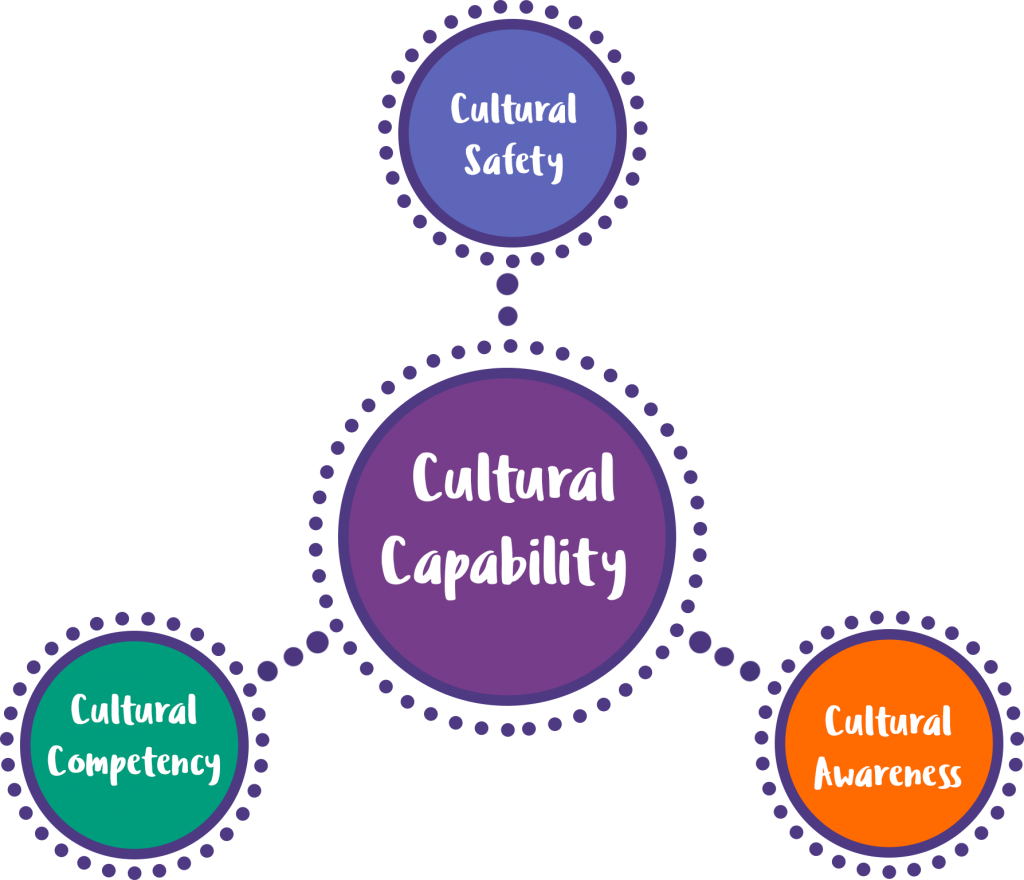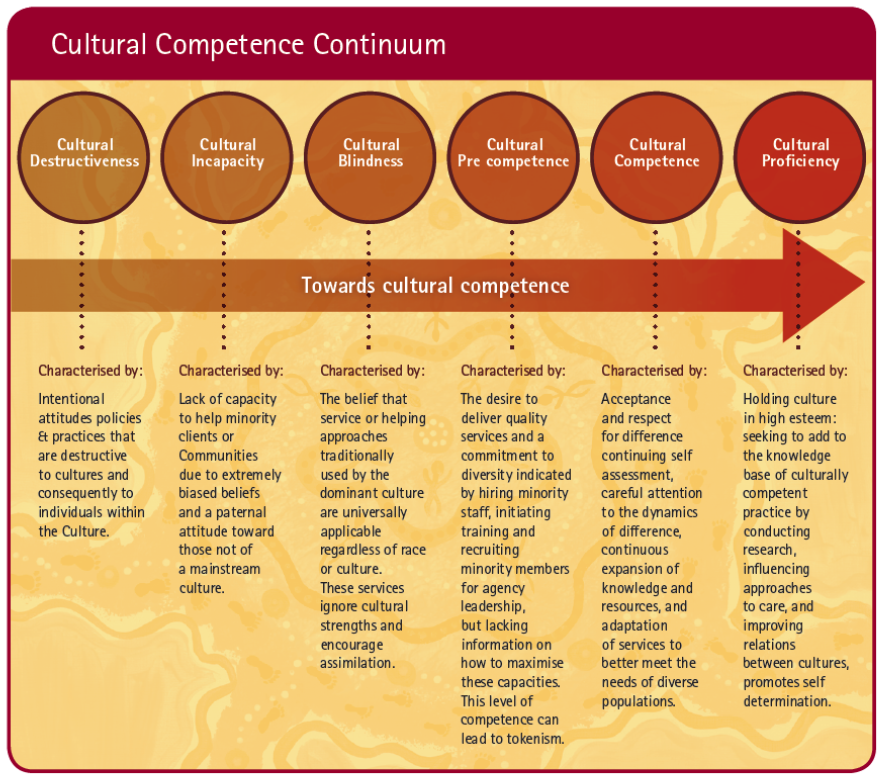Cultural capability is not achieved after one training session or at a single end-point but represents continuous learning that builds over time.

Cultural Awareness
Cultural awareness means being aware of, and developing sensitivity to, cultural difference and cultural diversity. It involves knowledge, attitudes and values that demonstrate an openness and respect for other people and other cultures, languages, religions, dress, communication styles and so on. For example, in some Aboriginal and/or Torres Strait Islander cultures it may be considered rude or disrespectful to make eye contact, while in others it is not.1
Cultural Safety
Cultural safety is an environment which is safe for Aboriginal and/or Torres Strait Islander people, where there is no assault, challenge or denial of their identity and experience. Cultural safety is about individuals, organisations and systems being aware of the impact of their own culture and cultural values on Aboriginal and/or Torres Strait Islander people, while creating and maintaining an environment where all people are treated in a culturally respectful manner.
Tips for achieving a culturally safe workplace:
- Include an Acknowledgment of Country at the beginning of all formal meetings.
- Have an Acknowledgment plaque at the entrance to your building that acknowledges the Traditional Owners of your area.
- Display Aboriginal and Torres Strait Islander flags around the building
- Display Aboriginal and Torres Strait Islander art in workplaces.
- Participate in local Aboriginal and Torres Strait Islander community events and celebrations, such as NAIDOC Week, the commemoration of the National Apology to the Stolen Generations and National Aboriginal and Islander Children’s Day.
- Use Aboriginal and Torres Strait Islander artwork and designs in its promotional and educational material intended for Aboriginal and/or Torres Strait Islander people. However, it is important to ensure that you respect the copyright and intellectual property of the Aboriginal and/or Torres Strait Islander artists and creative workers who created the artwork. For more information please see Working and Walking Together (PDF, 5.7mb).
Measures of a culturally safe workplace:
- Cultural safety is an organisational value and is negotiated with local Aboriginal and/or Torres Strait Islander communities.
- Policies and procedures are reviewed and refreshed based on Aboriginal and/or Torres Strait Islander staff and community feedback and are aligned with the VAAF and self-determination principles.
- Local Aboriginal and/or Torres Strait Islander communities and the organisation negotiate strategic approaches, goals and outcomes.
- The organisation has systems to determine current proficiency and capability levels and to identify a learning or development plan based on the organisations learning needs.
- The Commonwealth public sector Aboriginal and Torres Strait Islander Cultural Capability Map are broken cultural capabilities into: knowing; doing; and being. The ‘foundation’ level that applies to all Commonwealth employees regardless of role, function, or level lists the following capabilities.2
Cultural Competency
Cultural competency is a set of behaviours, attitudes and policies that come together to allow people to work effectively in cross-cultural situations. It is best understood as something people move towards along a continuum rather than a point in time achievement. See VACCA Building Respectful Partnerships 2010 (PDF, 1.8mb).
This diagram draws from work done by VACCA for the Aboriginal Cultural Competency Framework and Muriel Bamblett’s Keynote Speech at SNAICC 2007 National Conference in Adelaide, which in turn drew from work by Terry Cross of the National Indian Child Welfare Association (US).

Cultural Capability Training
Cultural capability training is an integral part of workplace health and safety and is essential for enabling cultural safety in the workplace. Cultural capability training should be ongoing rather than just done once. There are many aspects to cultural capability training, such as: cultural awareness, cultural competency and unconscious bias.
Many Victorian Aboriginal and/or Torres Strait Islander organisations provide cultural training. Try to choose a local Aboriginal and/or Torres Strait Islander training provider who has knowledge of local Aboriginal and/or Torres Strait Islander history and culture. You should contact your local Traditional Owners or Local Aboriginal Community Controlled Organisation (ACCO) to discuss training options. Some organisations have Traditional Owner Settlement Agreements and therefore must seek training through appropriate Traditional Owners.
Questions for managers and workplaces when building cultural capability:
- What strategies have you put in place to build cultural competency and cultural safety for your staff and the Aboriginal and/or Torres Strait Islander people working within your area/organisation?
- Has your team completed any cultural awareness/cultural competency training?
- Does your team celebrate significant Aboriginal and Torres Strait Islander cultural events?
- Do you identify and challenge inappropriate behaviours in others and create a safe space for Aboriginal and/or Torres Strait Islander staff to report if required?
- Do you understand what is expected of you in responding to racism, discrimination and cultural abuse?
Useful links and other information
The ‘Deadly Story’ website has a list of Aboriginal and/or Torres Strait Islander service providers across Victoria. You can use the list to find an organisation local to your area.
More information on doing an Acknowledgement of Country
Purchasing Acknowledgement plaques
Information on how to display flags
(1) Working with Indigenous Australians – Culture
(2) Aboriginal and Torres Strait Islander cultural capability: A framework for Commonwealth agencies
